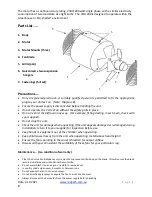
P a g e
|
2
History
Horizontal airflow principles have been around for many years and Redpath Pacific Ltd have
been distributing Vortex circulation fans for over 20 years. They are used in many applications
worldwide.
The 510 series of Redpath Vortex Fan has been designed to offer improved corrosion
resistance.
Following the simple instructions will ensure your Vortex Fan operates for many years to come
and is an extremely worthwhile investment.
How do Vortex Fans Work?
The very simple principle of Horizontal air flow is firstly to invigorate the internal environment
and secondly to circulate, mix and stabilize the temperature regime. In still air, warm air rises
and will quickly pool in the highest point of the roof, however this is very easily prevented by
causing some gentle air motion. This air motion needs only to be very slight but thoroughly
throughout the entire house.
The third but most important benefit is the reduction in fungal sprays required as a result of
installing Vortex Fans.
The reason for this is that the gentle air movement displaces transpiration moisture from the
foliage and lowers the dew point at the leaf surface. The combination of air movement and
drier foliage radically inhibits fungal growth of all kinds and may substantially reduce the need
to use fungicides.
Originally butcher’s type vertical ceiling fans were used but growers soon found detrimental
side effects in the crop directly underneath. Also considerably fewer VORTEX FANS are
required per house.
As a result Horizontal Air Flow is now accepted as the industry standard.
Installation Suggestions;
In a greenhouse situation, to generate a circular horizontal air movement, site the unit above
head height and approximately 3-10 metres in from the gable end wall and 3-8 metres or one
third from the side wall. (See Diagram A). This will provide a gentle drift down one side across
the end and back up the opposite side where it will be recirculated.
Suspend the units from chain or stout cord and attach to the roof at strong supports longer
than the actual fan. This will brace the fan and prevent any swinging or sway induced by the
airflow.
Use one fan per bay and on multibay structures; site each adjacent fan at opposite ends of the
house. In longer houses than 35-40 metres we would suggest a second fan unit be situated
halfway down the bay to assist air movement full length.
In poultry houses the siting of the VORTEX FAN is virtually the same, well above bird and head
height in similar positions to create the circular movement.
The Vortex Fan may be interlocked with ventilation fans or heaters to operate at similar times
or merely left operating constantly.






















